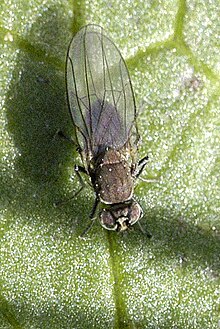Brine fly
| Ephydridae | |
|---|---|
 |
|
| Hydrellia griseola | |
| Scientific classification | |
| Kingdom: | Animalia |
| Phylum: | Arthropoda |
| Class: | Insecta |
| Order: | Diptera |
| Suborder: | Brachycera |
| Section: | Schizophora |
| Subsection: | Acalyptratae |
| Superfamily: | Ephydroidea |
| Family: | Ephydridae |
| Subfamilies and tribes | |
|
|
Ephydridae (shore fly, sometimes brine fly) is a family of insects in the order Diptera.
Shore flies are tiny flies that can be found near seashores or at smaller inland waters, such as ponds. About 2,000 species have been described worldwide, including Ochthera.
The petroleum fly, Helaeomyia petrolei, is the only known insect whose larvae live in naturally occurring crude petroleum. Another notable species is Ephydra hians which lives in vast number at Mono Lake.
For terms see Morphology of Diptera
Minute to small (0.9 to 7.0 mm.) flies, black or gray. Wings sometimes patterned. Costa with two interruptions in first section (near the humeral cross-vein and again near the end of vein 1.Second basal cell not separated from discal cell. Arista bare or with hairs on the upper side (plumose on the upper side). Mouth opening very large in some species. Ratio of vertical diameter of eye and height of gena (face index) widely used in identification of species.
See Family description and images
In the tribe Notiphilini the head is reduced to a cephalic skeleton, there are no anterior spiracles and the posterior spiracles are extended as spines. The other taxa have larvae similar to the Sciomyzidae, with the posterior spiracles at the apices of divergent branches from a common base. They may be differentiated by short thoracic segments (like the abdominal ones) and by the absence of a ventral arch linking the mouth hooks.
Ephydridae occupy a diverse array of seashore and wetland habitats including hot springs, petroleum pools, salt pools, alkaline lakes, marshes. Imago are phytophagous, sometimes feeding on microscopic algae and bacteria (Paracoenia, Ephydra), or predatory (Ochthera, Ephydrinae). As larvae, many are phytophagous, grazing on aquatic plants (including cultivated rice), others are algal grazers or saprophagous. Larvae of Trimerina are predatory. Some species are an important food source for other animals. Others cause damage to agricultural crops.
...
Wikipedia
